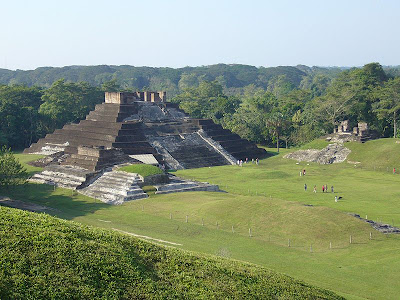 The Maya "Long Count" calendar and its connection to 2012 has long been a topic of controversy (INAH).
The Maya "Long Count" calendar and its connection to 2012 has long been a topic of controversy (INAH). MEXICO CITY - Mexico's archaeology institute downplays theories that the ancient Maya predicted some sort of apocalypse would occur in 2012. But on [Thanksgiving, 2011] it acknowledged that a second reference to the date exists on a carved fragment found at a southern Mexico ruin site.
MEXICO CITY - Mexico's archaeology institute downplays theories that the ancient Maya predicted some sort of apocalypse would occur in 2012. But on [Thanksgiving, 2011] it acknowledged that a second reference to the date exists on a carved fragment found at a southern Mexico ruin site.
Most experts had cited only one surviving reference to the date in Mayan glyphs, a stone tablet from the Tortuguero site [a word that means "Region of Turtles"] in the [Mexican] Gulf coast state of Tabasco. [This "Tortuguero stone" is pictured on left.]
But the National Institute of Anthropology and History said in a statement that there is in fact another apparent reference to the date at the nearby Comalcalco ruin. The inscription is on the carved or molded face of a brick. Comalcalco is unusual among Mayan temples in that it was constructed of bricks.
- The Tortuguero stone tablet apparently refers to an event that is due to occur in 2012, but a crack in the stone makes the final passage almost illegible (INAH).
Arturo Mendez, a spokesman for the institute, said the fragment of inscription had been discovered years ago and has been subject to thorough study. It is not on display and is being kept in storage at the institute.
 Doomsdayism: In Nov. 2011, Mark Stevenson authored an article in the Seattle Times claiming that Mexico's INAH revealed a reference to the Dec. 2012 "doomsday" date on a second glyph found at the Comalcalco ruin site, an inscription carved on a brick.[1]
Doomsdayism: In Nov. 2011, Mark Stevenson authored an article in the Seattle Times claiming that Mexico's INAH revealed a reference to the Dec. 2012 "doomsday" date on a second glyph found at the Comalcalco ruin site, an inscription carved on a brick.[1]
The "Comalcalco Brick" [here], as the second fragment is known, has been discussed by experts in some online forums. Many still doubt that it is a definite reference to Dec. 21, 2012 or Dec. 23, 2012, the dates cited by proponents of the theory as the possible end of the [age, not] world.
Referring to past or future?
"Some have proposed it as another reference to 2012, but I remain rather unconvinced," David Stuart, a specialist in Mayan epigraphy at the Univ. of Texas at Austin, said in a message to the AP.
Stuart said the date inscribed on the brick "'is a 'Calendar Round,' a combination of a day and month position that will repeat every 52 years."
The brick date does coincide with the end of the 13th Baktun; Baktuns were roughly 394-year periods, and 13 was a significant, sacred number for the Mayas. The Mayan Long Count calendar begins in 3114 B.C., and the 13th Baktun ends around Dec. 21, 2012.
But the date on the brick could also correspond to similar dates in the past, Stuart said.
"There's no reason it couldn't be also a date in ancient times, describing some important historical event in the Classic period. In fact, the third glyph on the brick seems to read as the verb huli, 'he/she/it arrives,'" Stuart wrote. "There's no future tense marking (unlike the Tortuguero phrase), which in my mind points more to the Comalcalco date being more historical than prophetic."
 The Mayan universe looks like the mandalas of Buddhist cosmology (imageshack.us).
The Mayan universe looks like the mandalas of Buddhist cosmology (imageshack.us).
Cryptic characteristics Both inscriptions -- the Tortuguero tablet and the Comalcalco brick -- were probably carved about 1,300 years ago, and both are cryptic in some ways.
Both inscriptions -- the Tortuguero tablet and the Comalcalco brick -- were probably carved about 1,300 years ago, and both are cryptic in some ways.
 Tibetan (Vajrayana) monks depict the Buddhist universe in an intricate sand mandala.
Tibetan (Vajrayana) monks depict the Buddhist universe in an intricate sand mandala.
The Comalcalco brick is also odd in that the molded or inscribed faces of the bricks were probably laid facing inward or covered with stucco, suggesting they were not meant to be seen.
The Institute of Anthropology and History has long said rumors of a world-ending or world-changing event in late December 2012 are a Westernized misinterpretation of Mayan calendars.
The institute repeated Thursday that "Western messianic thought has twisted the cosmovision of ancient civilizations like the Maya."
The institute's experts say the Maya [just like the Buddhists and brahmins] saw time as a series of cycles that began and ended with regularity, but with nothing apocalyptic at the end of a given cycle.
Given the strength of Internet rumors about impending disaster in 2012, the institute is organizing [yet another] special round table of 60 Mayan experts next week at the archaeological site of Palenque, in southern Mexico, to "dispel some of the doubts about the end of one era and the beginning of another, in the Mayan Long Count calendar."
 The kalpas (aeons) spin round in endless cycles of creation, stagnation, dissolution, and re-evolution in Buddhist cosmology.
The kalpas (aeons) spin round in endless cycles of creation, stagnation, dissolution, and re-evolution in Buddhist cosmology.
































































































































































































































No comments:
Post a Comment